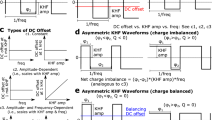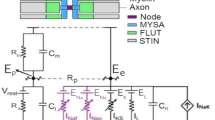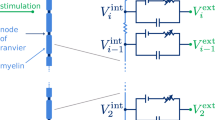Abstract
Interferential current (IFC) is one of the most popular electrical currents used in electrotherapy. However, there have been limited studies investigating how this stimulation affects the nerve fibers. The aim of this computational study was to evaluate the temporal and spatial patterns of fiber activation in IFC therapy for different modulation and carrier frequencies. The interferential currents were applied by two pairs of point electrodes perpendicular to each other in an infinite homogeneous medium, and a model of myelinated nerve fibers was implemented in NEURON to study the neural response. The activation thresholds for different positions of the fiber and the resultant firing patterns were evaluated. The results suggest that the fibers may fire continuously or in bursts, with frequencies equal or higher than the modulation frequency, or may be blocked, based on their position relative to the electrodes, the modulation frequency and the stimulus strength. The results confirm traditional belief about the role of the modulation frequency in firing frequency of nerve fibers and describe a possible mechanism for less sensation of pain, due to blockage of the fibers by the high-frequency nature of the interferential currents.







Similar content being viewed by others
References
Abulkhair B, Rayner A, Chipchase L, Souvlis T (2011) Penetration and spread of interferential current in cutaneous, subcutaneous and muscle tissues. Physiotherapy 97(4):319–326
Chiu S, Ritchie R, Rogart R, Stagg D (1979) A quantitative description of membrane currents in rabbit myelinated nerve. J Physiol 292:149–166
Goats G (1990) Interferential current therapy. Br J Sports Med 24:87–92
Khurana I (2006) Text book of medical physiology. Elsevier, Amsterdam
Kilgore KL, Bhadra N (2004) Nerve conduction block utilizing high-frequency alternating current. Med Biol Eng Comput 42:394–406
Kuhn A, Keller T, Lawrence M, Morari M (2009) A model for transcutaneous current stimulation: simulations and experiments. Med Biol Eng Comput 47:279–289
Manzouri F, Mahnam A, Emadi M (2011) A computational study to evaluate the mechanism of selectivity in interferential current therapy. In: Proceedings of 18th ICBME, Tehran
Marijke H, Els M, Ineke S, Coen van S (2005) Interferential therapy manual. Enraf Nonius company http://www.enraf-nonius.com/docman-downloads/doc_download/148-electrotherapy-interferentialtherapy-1433762-42-zip. Accessed 19 Mar 2015
McIntyre C, Richardson A, Grill WM (2002) Modeling the excitability of mammalian nerve fibers: influence of after potentials on the recovery cycle. J Neurophysiol 87:995–1006
Mesin L, Merletti R (2008) Distribution of electrical stimulation current in a planar multilayer anisotropic tissue. IEEE Trans Biomed Eng 55(2):660–670
Nemec H (1959) Interferential therapy: a new approach in physical medicine. Br J Physiother 12:9–12
Ozcan J, Ward AR, Robertson VJ (2004) A comparison of true and premodulated interferential currents. Arch Phys Med Rehabil 85:409–415
Palmer ST, Martin DJ, Steedman WM, Ravey J (1999) Alteration of interferential current and transcutaneous electrical nerve stimulation frequency: effects on nerve excitation. Arch Phys Med Rehabil 80:1065–1071
Rattay F (1986) High frequency electrostimulation of excitable cells. J Theor Biol 123:45–54
Rattay F (1999) The basic mechanism for the electrical stimulation of the nervous system. Neuroscience 88:335–346
Robertson VJ, Ward AR, Low J, Reed A (2006) Electrotherapy explained: principles and practice, 4th edn. Butterworth Heinemann, Oxford
Treffene RJ (1983) Interferential fields in a fluid medium. Aust J Physiother 29:209–216
Ward AR (2009) Electrical stimulation using kilohertz-frequency alternating current. Phys Ther 89:181–190
Ward AR, Robertson VJ (1998) Sensory, motor, and pain thresholds for stimulation with medium frequency alternating current. Arch Phys Med Rehabil 79:273–278
Wesselink W, Holsheimer J, Boom H (1999) A model of electrical behaviour of myelinated sensory nerve fibers based on human data. Med Biol Eng Comput 37:228–235
Author information
Authors and Affiliations
Corresponding author
Rights and permissions
About this article
Cite this article
Agharezaee, M., Mahnam, A. A computational study to evaluate the activation pattern of nerve fibers in response to interferential currents stimulation. Med Biol Eng Comput 53, 713–720 (2015). https://doi.org/10.1007/s11517-015-1279-6
Received:
Accepted:
Published:
Issue Date:
DOI: https://doi.org/10.1007/s11517-015-1279-6




